Do you have a question about the Emerson dixell XT111D and is the answer not in the manual?
Essential warnings and safety measures before operating the instrument. Includes electrical safety and environmental considerations.
Overview of the XT110C, XT111C, XT110D, XT111D single-stage digital controllers and their input capabilities.
Procedure for initial installation and configuring the probe type for the digital controller.
Explanation of the front panel buttons (SET, UP, DOWN) and their functions in operation and programming.
Description of the function of each LED on the front panel for monitoring instrument status.
Instructions on how to view the current setpoint and how to change it.
Steps to access and navigate the PR1 (user) and PR2 (configuration) parameter lists.
Procedure for moving parameters between the user-accessible PR1 menu and the configuration PR2 menu.
Detailed steps for modifying the value of any parameter within the programming menus.
How to lock the keyboard to prevent accidental changes and how to unlock it.
How to switch the instrument ON and OFF using the SET key, if the function is enabled.
Details on supported probe types (NTC, PTC, Pt100, Thermocouple) and their respective measuring ranges.
Detailed explanation of regulation parameters like differential, setpoint limits, and action type.
Configuration parameters for temperature alarms, alarm delays, and recovery settings.
Parameters related to probe calibration, display resolution, and measurement units.
Instructions for mounting the controller on a panel or DIN rail and environmental considerations.
Guidance on making correct electrical connections for power supply, probes, and outputs.
Information on connecting the instrument to a monitoring system via serial port using an XJ485 module.
Procedures for programming a hot key from the instrument (upload) and programming the instrument using a hot key (download).
Configuring the digital input for various functions like inverting action, remote ON/OFF, generic or serious alarms, and energy saving.
List of alarm messages, their causes, and the corresponding status of the output relays.
Defines the status of the alarm relay based on the AS parameter and instrument status.
How to silence the buzzer and how the alarm relay status is affected by the 'tbA' parameter.
Explanation of how probe and other alarms recover after the fault condition is resolved.
Comprehensive technical specifications including housing, dimensions, power supply, inputs, outputs, and operating conditions.
Wiring diagram for XT110C models with 12V AC/DC or 24V AC/DC power supply.
Wiring diagram for XT110C models with 230V AC or 115V AC power supply.
Wiring diagram for XT111C models with 12V AC/DC or 24V AC/DC power supply.
Wiring diagram for XT111C models with 230V AC or 115V AC power supply.
Wiring diagram for XT110D models with 230V AC, 120V AC, or 24V AC power supply.
Wiring diagram for XT111D models with 230V AC, 120V AC, or 24V AC power supply.
A table listing all configurable parameters, their ranges, default values, and access level (Pr1/Pr2).
Essential warnings and safety measures before operating the instrument. Includes electrical safety and environmental considerations.
Overview of the XT110C, XT111C, XT110D, XT111D single-stage digital controllers and their input capabilities.
Procedure for initial installation and configuring the probe type for the digital controller.
Explanation of the front panel buttons (SET, UP, DOWN) and their functions in operation and programming.
Description of the function of each LED on the front panel for monitoring instrument status.
Instructions on how to view the current setpoint and how to change it.
Steps to access and navigate the PR1 (user) and PR2 (configuration) parameter lists.
Procedure for moving parameters between the user-accessible PR1 menu and the configuration PR2 menu.
Detailed steps for modifying the value of any parameter within the programming menus.
How to lock the keyboard to prevent accidental changes and how to unlock it.
How to switch the instrument ON and OFF using the SET key, if the function is enabled.
Details on supported probe types (NTC, PTC, Pt100, Thermocouple) and their respective measuring ranges.
Detailed explanation of regulation parameters like differential, setpoint limits, and action type.
Configuration parameters for temperature alarms, alarm delays, and recovery settings.
Parameters related to probe calibration, display resolution, and measurement units.
Instructions for mounting the controller on a panel or DIN rail and environmental considerations.
Guidance on making correct electrical connections for power supply, probes, and outputs.
Information on connecting the instrument to a monitoring system via serial port using an XJ485 module.
Procedures for programming a hot key from the instrument (upload) and programming the instrument using a hot key (download).
Configuring the digital input for various functions like inverting action, remote ON/OFF, generic or serious alarms, and energy saving.
List of alarm messages, their causes, and the corresponding status of the output relays.
Defines the status of the alarm relay based on the AS parameter and instrument status.
How to silence the buzzer and how the alarm relay status is affected by the 'tbA' parameter.
Explanation of how probe and other alarms recover after the fault condition is resolved.
Comprehensive technical specifications including housing, dimensions, power supply, inputs, outputs, and operating conditions.
Wiring diagram for XT110C models with 12V AC/DC or 24V AC/DC power supply.
Wiring diagram for XT110C models with 230V AC or 115V AC power supply.
Wiring diagram for XT111C models with 12V AC/DC or 24V AC/DC power supply.
Wiring diagram for XT111C models with 230V AC or 115V AC power supply.
Wiring diagram for XT110D models with 230V AC, 120V AC, or 24V AC power supply.
Wiring diagram for XT111D models with 230V AC, 120V AC, or 24V AC power supply.
A table listing all configurable parameters, their ranges, default values, and access level (Pr1/Pr2).
| Model | XT111D |
|---|---|
| Type | Temperature Controller |
| Input Type | NTC |
| Display | LCD |
| Power Supply | 12 Vac/dc |
| Hysteresis | Adjustable |
| Protection | IP20 |
| Series | Dixell |
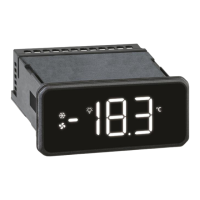
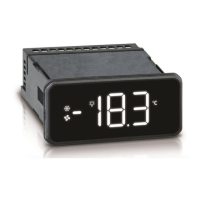

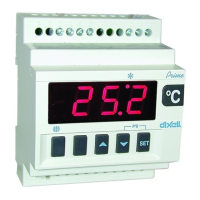

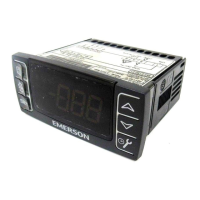
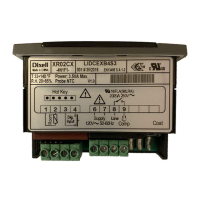
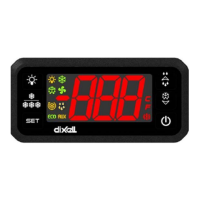
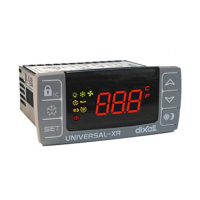
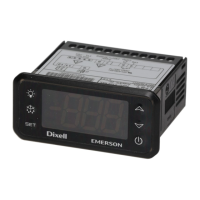
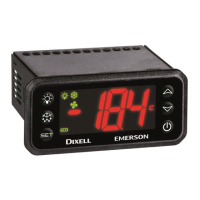
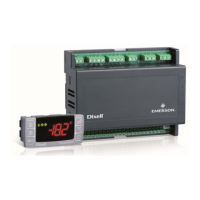
